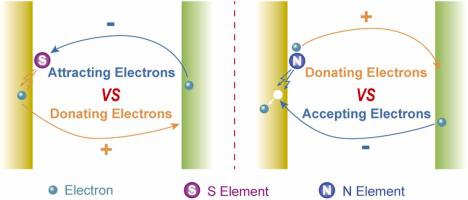当前位置:
X-MOL 学术
›
Nano Energy
›
论文详情
Our official English website, www.x-mol.net, welcomes your feedback! (Note: you will need to create a separate account there.)
“Electron-donating effect” of element S and “electron-accepting effect” of element N in regulating the interfacial contact electrification
Nano Energy ( IF 17.6 ) Pub Date : 2024-03-28 , DOI: 10.1016/j.nanoen.2024.109547 Jie Yang , Shiyi Ge , Zixiong Fan , Tinghao Jia , Yao Yang , Zhengliang Huang , Jingdai Wang , Yongrong Yang
Nano Energy ( IF 17.6 ) Pub Date : 2024-03-28 , DOI: 10.1016/j.nanoen.2024.109547 Jie Yang , Shiyi Ge , Zixiong Fan , Tinghao Jia , Yao Yang , Zhengliang Huang , Jingdai Wang , Yongrong Yang

|
Enhancing the surface charge density through interface modification is crucial for the design of triboelectric energy harvesting devices (triboelectric nanogenerator, TENG). Based on the electron transfer theory, loading electron-accepting elements (F, S) on the material surface will enhance the negative charge, and loading electron-donating elements (N) will enhance the positive charge. However, this paper finds a new electron-transfer regulation effect that is completely contrary to that mentioned above both in contact electrification of material-identical solid materials and liquid-solid interface. In the contact electrification of identical materials, the electron-accepting element S enhances the positive charge, while the electron-donating element N enhances the negative charge. More liquid-solid interfacial contact electrification experiments based on the droplet-triboelectric nanogenerator (Droplet-TENG) show that if the solid material is negatively charged after contacting with water droplet, loading the element S on the solid will enhance the negative charge, and loading the element N will enhance the positive charge. Unexpectedly, if the solid material is positively charged after contacting with water droplet, loading the element S on the solid will enhance the positive charge, and loading the element N will enhance the negative charge. Namely, in the contact electrification of material-identical solid materials and special liquid-solid interface, element S actually becomes “electron-donating” and element N actually becomes “electron-accepting”. We infer that the effect of elements on electron-transfer is directly related to the fundamental electron transfer direction of the material. This work can provide totally new perspective for the regulation of interfacial triboelectric behavior and material surface design of TENG.
中文翻译:

S元素的“给电子效应”和N元素的“受电子效应”调节界面接触带电
通过界面改性提高表面电荷密度对于摩擦电能量收集装置(摩擦纳米发电机,TENG)的设计至关重要。根据电子转移理论,在材料表面负载受电子元素(F、S)会增强负电荷,负载给电子元素(N)会增强正电荷。然而,本文在材料相同的固体材料和液固界面的接触起电中发现了与上述完全相反的新的电子传递调节效应。相同材料接触起电时,受电子元素S增强正电荷,而给电子元素N增强负电荷。更多基于液滴摩擦纳米发电机(Droplet-TENG)的液固界面接触起电实验表明,如果固体材料与水滴接触后带负电,在固体上负载元素S会增强负电荷,并且负载N元素会增强正电荷。出乎意料的是,如果固体材料与水滴接触后带正电荷,则在固体上负载元素S会增强正电荷,负载元素N会增强负电荷。即,在材质相同的固体材料和特殊的液固界面接触起电时,S元素实际上成为“给电子”,N元素实际上成为“受电子”。我们推断元素对电子转移的影响与材料的基本电子转移方向直接相关。这项工作可以为TENG界面摩擦起电行为的调控和材料表面设计提供全新的视角。
更新日期:2024-03-28
中文翻译:

S元素的“给电子效应”和N元素的“受电子效应”调节界面接触带电
通过界面改性提高表面电荷密度对于摩擦电能量收集装置(摩擦纳米发电机,TENG)的设计至关重要。根据电子转移理论,在材料表面负载受电子元素(F、S)会增强负电荷,负载给电子元素(N)会增强正电荷。然而,本文在材料相同的固体材料和液固界面的接触起电中发现了与上述完全相反的新的电子传递调节效应。相同材料接触起电时,受电子元素S增强正电荷,而给电子元素N增强负电荷。更多基于液滴摩擦纳米发电机(Droplet-TENG)的液固界面接触起电实验表明,如果固体材料与水滴接触后带负电,在固体上负载元素S会增强负电荷,并且负载N元素会增强正电荷。出乎意料的是,如果固体材料与水滴接触后带正电荷,则在固体上负载元素S会增强正电荷,负载元素N会增强负电荷。即,在材质相同的固体材料和特殊的液固界面接触起电时,S元素实际上成为“给电子”,N元素实际上成为“受电子”。我们推断元素对电子转移的影响与材料的基本电子转移方向直接相关。这项工作可以为TENG界面摩擦起电行为的调控和材料表面设计提供全新的视角。



























 京公网安备 11010802027423号
京公网安备 11010802027423号